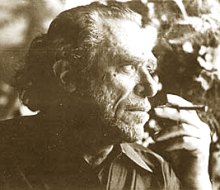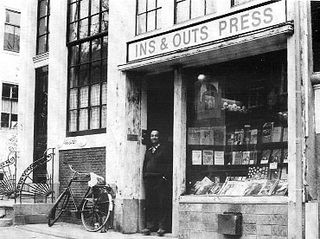
Henry Charles Bukowski was an American poet, novelist, and short story writer. His writing was influenced by the social, cultural, and economic ambience of his adopted home city of Los Angeles. Bukowski's work addresses the ordinary lives of poor Americans, the act of writing, alcohol, relationships with women, and the drudgery of work. The FBI kept a file on him as a result of his column Notes of a Dirty Old Man in the LA underground newspaper Open City.

Philip Lamantia was an American poet, writer and lecturer. His poetry incorporated stylistic experimentation and transgressive themes, and has been regarded as surrealist and visionary, contributing to the literature of the Beat Generation.
The Evergreen Review is a U.S.-based literary magazine. Its publisher is John Oakes and its editor-in-chief is Dale Peck. The Evergreen Review was founded by Barney Rosset, publisher of Grove Press. It existed in print from 1957 until 1984, and was re-launched online in 1998, and again in 2017. Its lasting impact can be seen in the March–April 1960 issue, which included work by Albert Camus, Lawrence Ferlinghetti, Bertolt Brecht and Amiri Baraka, as well as Edward Albee's first play, The Zoo Story (1958). The Camus piece was a reprint of "Reflections on the Guillotine", first published in English in the Review in 1957 and reprinted on this occasion as the magazine's "contribution to the worldwide debate on the problem of capital punishment and, more specifically, the case of Caryl Whittier Chessman." Its commitment to the progressive side of the political spectrum has been consistent, with early stance for civil rights and against the Vietnam War. The image of Che Guevara that first appeared on the cover of its February 1968 issue, designed by Paul Davis and based on a photograph by Alberto Korda, became a popular symbol of resistance.

Jack Micheline, born Harold Martin Silver, was an American painter and poet from the San Francisco Bay Area. One of San Francisco's original Beat poets, he was an innovative artist who was active in the San Francisco Poetry Renaissance of the 1950s and 1960s.
Neeli Cherkovski is an American poet and memoirist, who has resided since 1975 in San Francisco.

Harold Norse was an American writer who created a body of work using the American idiom of everyday language and images. One of the expatriate artists of the Beat generation, Norse was widely published and anthologized.

Transatlantic Review was a literary journal founded in 1959 by Joseph F. McCrindle, who remained its editor until he closed the magazine in 1977. Published quarterly, at first in Rome and then in London and New York, TR was known for its eclectic mix of short stories and poetry—by both young, previously unpublished writers and prominent authors such as Samuel Beckett, Iris Murdoch, Grace Paley and John Updike—as well as drawings, essays, and interviews with writers and theater and film directors.

Frederick Arthur Nettelbeck was an American poet. In the early 1970s he began work on a long poem that was published in 1979: Bug Death. Cut-up and collage texts were combined with original writing to create Bug Death. His literary magazine, This Is Important (1980–1997), published such writers as William S. Burroughs, Wanda Coleman, John M. Bennett, Jack Micheline, Allen Ginsberg, Robin Holcomb, Charles Bernstein, John Giorno, Greg Hall, etc. His other publication of note was a Small press mimeo magazine: Throb (1971), publishing Al Masarik, Susan Fromberg Schaeffer, Gerald Locklin, Joel Deutsch, and 'Charles Bukowski answers 10 easy questions'. Nettelbeck's work, publications, and papers are collected in the Ohio State University Avant Writing Collection and the Sackner Archive of Concrete and Visual Poetry. His autobiography is published in Contemporary Authors, Volume 184. He lived in southern Oregon's Sprague River Valley.

Eddie Woods is an American poet, prose writer, editor and publisher who lived and traveled in various parts of the world, both East and West, before eventually settling in Amsterdam, Netherlands, where in 1978 he started Ins & Outs magazine and two years later founded Ins & Outs Press. He was born on May 8, 1940 in New York City.

Ins & Outs Press is a small English-language publisher with international connections based in Amsterdam and registered in the Netherlands as a cultural foundation, or stichting. It was started in 1980 by Eddie Woods, Jane Harvey, and Henk van der Does as a natural extension of Ins & Outs magazine, the first three issues of which were produced by Woods and Harvey in 1978. For two years the Press also operated a bookstore, located on the 'quiet fringe of the red-light district,' until Van der Does left the organization to start his own bookshop and Woods converted the ground floor of the six-story building into a gallery and performance space.
Laugh Literary and Man the Humping Guns was a mimeographed literary magazine published between 1969 and 1971 in Los Angeles, California by Charles Bukowski and Neeli Cherkovski. The original title was to be "Laugh Literary and Man the Fucking Guns," but Cherkovski convinced Bukowski to substitute a less graphic word due to censorship concerns. In the late 1960s, the U.S. Post Office was actively prosecuting publishers for sending "obscene" publications through the mail. At the time of its publication, Bukowski was working as a clerk at the Post Office, having not yet made the transition to full-time writer.
Douglas Blazek is a Polish-American poet and editor who published the literary chapbook Ole and was proprietor of the Open Skull Press.
Lewis Warsh was an American poet, visual artist, professor, prose writer, editor, and publisher. He was a principal member of the second generation of the New York School poets,; however, he has said that “no two people write alike, even if they’re associated with a so-called ‘school’ .” Professor of English at Long Island University and founding director (2007–2013) of their MFA program in creative writing, Warsh lived in Manhattan with his wife, playwright-teacher Katt Lissard, whom he married in 2001.

Allan Davis Winans, known as A. D. Winans, is an American poet, essayist, short story writer and publisher. Born in San Francisco, California, he returned home from Panama in 1958, after serving three years in the military. In 1962, he graduated from San Francisco State College.
Linda King is an American sculptor, playwright and poet. She is best known for having been the girlfriend of American writer Charles Bukowski for several years in the early 1970s.
Chicago Review is a literary magazine founded in 1946 and published quarterly in the Humanities Division at the University of Chicago. The magazine features contemporary poetry, fiction, and criticism, often publishing works in translation and special features in double issues.
Second Coming Press was a San Francisco-based small press founded by A. D. Winans that was in existence from 1972 to 1989. It specialized in publishing poetry and essays. Its published writers included Douglas Blazek, Charles Bukowski, Neeli Cherkovski, Art Cuelho, Paul Fericano, Gene Fowler, Hugh Fox, Linda King, Diane Kruchkow, Gerald Locklin, Al Masarik, Jack Micheline, Pablo Neruda, Morty Sklar and William Wantling.

Mark Terrill is a well-traveled American poet, translator, and prose writer who has resided in Northern Germany since the mid-1980s.
The Mimeo Revolution of the 1960s and 1970s was an active period of small-scale, non-commercial, literary publishing facilitated by the accessibility of the mimeograph. It is distinguished from the traditional private press by its emphasis on quick, cheap production.
Nomad was an avant-garde literary magazine that Anthony Linick and Donald Factor edited and published in Los Angeles between 1959 and 1962. The first issue came out in the winter of 1959. Linick and Factor were particularly drawn to the poetry and writing of the Beat Generation, who wrote of their own, frequently chaotic, lives.









